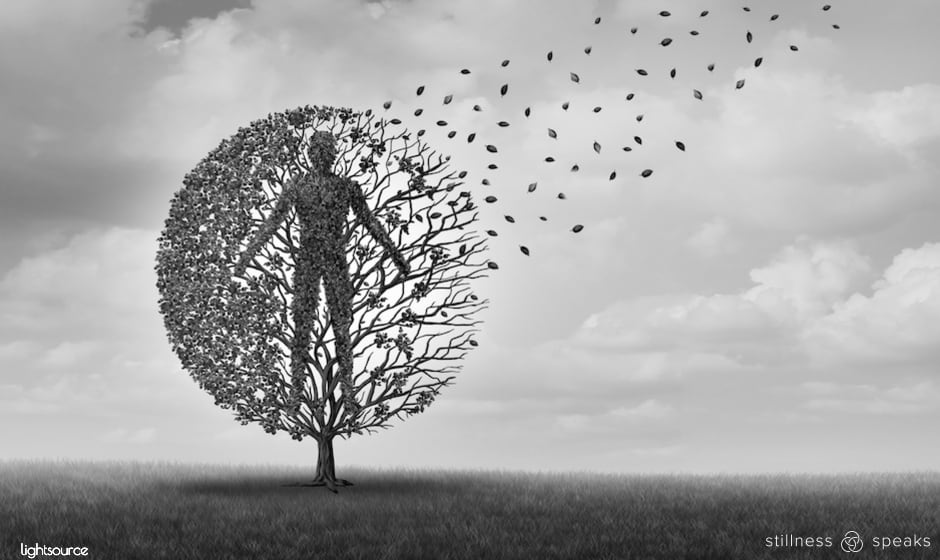the welcoming practice (bow, silence, love): “… To bow inside means to offer yourself in all humility, in your simple presence … to open to the openness that is silent, that is the background of every moment of our lives … to welcome in our hearts a glimpse of this divine love …“ ~ Elias Amidon
“There is only one truth, only men describe it in different ways.” ~The Rig Veda
Indeed, that single truth can be easily missed due to the differing rituals, visuals, doctrines, and other specifics of spiritual traditions … and given that we, at Stillness Speaks, are always looking at offering the underlying commonality, it is always a pleasure to find some teachings stemming from the fusion of several traditions.
And, such “finds” are even more important when they can be utilized in our everyday life … and help us see more of our common humanity which naturally leads to fostering unity – something we always encourage 🙂
So, it’s a real pleasure to offer Elias Amidon’s “… fusion of guidance from several mystical traditions…” … in the form of a practice that lends itself to letting go of our self identification, cultivating our humility, encourages embracing – and deepening – of silence, and opening our hearts to “divine love” … a practice that can certainly benefit us individually and collectively especially in these troubling and divisive times.
Elias is a Pir (Spiritual Director) of The Sufi Way and embodies such fusion in his life as his spiritual journey spanned Sufism, Theravada Buddhism, Native American, Christianity, Zen, and contemporary Dzogchen.
So, here is Elias’ Welcoming Practice that “.. welcomes these various forms of guidance that are united in their devotion to the same mystery …”
The Welcoming Practice
The Welcoming Practice is a fusion of guidance from several mystical traditions: Christianity, Sufism, Zen, Advaita, and Dzogchen in particular. It has its most direct antecedents in the Christian Centering Prayer practice as developed by a number of Catholic mystics (Merton, Keating, Menninger, Pennington, Bourgeault, and others) inspired by the 14th Century text The Cloud of Unknowing and the practices of earlier desert ascetics. However, this Welcoming Practice is a distinct variation drawing from the praxis of several traditions, which is one reason I’ve started calling it the Welcoming Practice — it welcomes these various forms of guidance that are united in their devotion to the same mystery.
The Welcoming Practice has three aspects which I call: Bow Inside; Consent to Silence; and Welcome Love. Though I’ll describe them here in sequence, you may find that when you engage in this practice these three aspects mingle and occur within and through each other, and are not as separate as they might sound in this description.
Bow Inside
It can happen that when you sit down to begin your meditation practice, a subtle pride sits down with you: See, now I’m a meditator, now I’m doing my practice. I’m a proper Sufi (or Buddhist or Christian). This subtle pride, which may be hard to spot, is a veil of identity that can obstruct one’s simple presence. When you sit down with your identity as an adherent of a particular tradition, you can’t help but see through its lens. To “bow inside” means to relinquish that identity as best you can, to give everything away that you think you know or have. As an early Sufi advised, “Put your forehead on the prayer mat and don’t presume.”
The “move” of bowing inside isn’t a physical movement, although it can have a kinaesthetic feel to it. Like a physical bow, this bow is a move toward self-effacement and unpretentiousness, a giving-over of one’s insularity: “Take me away from myself!” as Ibn Arabi cries in his beautiful prayer. To bow inside means to offer yourself in all humility, in your simple presence, during the sacred moments of this practice. Just your clear presence, nothing more.
In her wonderful descriptions of Centering Prayer, Cynthia Bourgeault points to a single line in The Cloud of Unknowing that suggests the essence of what I mean by bowing inside: it is to have, as the anonymous author of The Cloud writes: “Naked intent direct to God.” It is this “nakeding” that is the interior bow, an unclothing of your personhood to its simplicity and readiness, for in this practice you are inviting “God” to be with you, to open yourself to the unspeakable mystery of the numinous. To welcome its presence you cannot come adorned with self-identity; you have to come naked. Here you may wish to replace the word “God” with some other signifier that means the same thing — Naked intent direct to Pure Awareness, or Naked intent direct to Buddha Nature, or Naked intent direct to Silence.
Consent to Silence
“Consent to silence” is Father Thomas Keating’s concise instruction for this process of “nakeding.” To consent is to allow, to open to the openness that is silent, that is the background of every moment of our lives. One way to consent in this way is to recognize that our very capacity to listen is silent. Whatever listening is, it is silent. This is why the Advaita nondual teacher Jean Klein advises, “Listen to listening.” We recognize that pure awareness itself is silence. God is silence. Or in Father Keating’s words, “Silence is God’s first language.”
Now to the degree you have managed to bow inside and to consent to silence, you will soon experience distractions, mostly in the form of thoughts, or perhaps images, emotive currents or bodily sensations that draw your interested attention toward them. This is not a failure. In a way, it’s the heart of this practice, for each thought or sensation that attracts your attention gives you a chance to let it go, to relax the tension that your attention fixes upon it. That relaxing is the key. It will present itself as an opportunity again and again. Each time you notice you’ve attached your attention to some property that appears, relax. Consent to silence. As Zen master Dainin Katagiri points out, “… just put aside all kinds of imagination fabricated by your consciousness. Don’t attach to thoughts and emotions; just let them return to emptiness.”
Let the silence swallow them up. Consenting to silence means letting whatever has captured your attention return to emptiness. You don’t have to do anything to make this happen. As it is pointed out in Dzogchen texts: “All thoughts are self-liberated.” They vanish by themselves as soon as you relax your interest in them. This is why Sufi Inayat Khan called meditation mystical relaxation.
Welcome Love: The Welcoming Practice
At first I hesitated to use the word “love” to describe this aspect of the practice, since love is a word that so easily can seem sentimental or denote personal affection. In saying that, I don’t mean to disparage sentiment or affection — praise them! they are human resonances of the “divine” love that gives us this moment that blossoms everywhere as everything. To welcome love in the context of this practice means to welcome in our hearts a glimpse of this divine love — though again, to use the word “divine” may be just as perilous as using the word “love,” for it seems to imply a divinity or entity from which love is dispensed, and then we are caught in thinking dualistically about what is in essence not dualistic. Divine love is the radiance of Being, not something that issues forth from a God that is made into something separate in our minds.
But how can we welcome this vast, unspeakable love? Happily, it emerges by itself and welcomes us to the degree that we have consented to silence, which means we can’t make it happen through our insistence. And yet, “we can put ourselves in the way of it,” as Ibn Arabi tells us. Here we can take to heart an instruction from Plotinus, speaking of the same unspeakable love:
Let those who are unfamiliar with this state imagine, on the basis of their loves here down below, what it must be like to encounter the being they love most of all.
“Imagine what it must be like…” — that’s where we can start, in the imagination of the heart, not the mind. By grace such imagination breaks us lose from conceptions of love, and then divine love like an awesome wind takes over. Here we can no longer talk in prose — Sufis are especially enamoured of this kind of love poetry, and the 11th Century Persian Sufi, Abdullah Ansari, in his Book of Love, goes so far as to say Sufism is simply another word for love:
Love is the mark of the Tribe, the title of the Tariqah (Way)… It has three degrees:
The first degree is a love that cuts off disquieting thoughts, makes service enjoyable, and offers solace in afflictions…
The second degree is a love that incites preferring the Real to all else, elicits remembrance on the tongue, and attaches the heart to witnessing it…
The third degree is a dazzling love that cuts off expressing, makes allusions subtle, and does not reach description. This love is the pivot of this business…
I quote these love words to remind us that in this Welcoming Practice what we are inviting ourselves to be in the presence of is so awesome, sacred, and of a radiant, loving mystery so unknowable that we can only bow inside. To me, this practice has the capacity to take us beyond the quiet composure of recognizing nondual awareness — it passes through that doorway, yes — and then reveals to us a loving sacredness that is at the same time infinitely awesome and purely intimate.
~ Elias Amidon
NOTE: A printable PDF of “The Welcoming Practice” is available by clicking here.
And, here’s a gentle reminder to help those in times of extreme need … to that end we highlight two “hubs” of giving from which you can select your desired recipient(s) …
1) Direct Relief, which is “… a humanitarian aid organization, active in all 50 states and more than 80 countries, with a mission to improve the health and lives of people affected by poverty or emergencies – without regard to politics, religion, or ability to pay …” … and since 1948, it “… has worked to help people who confront enormous hardship to recover from disasters and improve the quality of their lives. The tradition of direct and targeted assistance, provided in a manner that respects and involves the people served, has been a hallmark of the organization since its founding …”
2) Go Fund Me continues to be a platform (amongst many others) for exercising – and deepening – our kindness and compassion. To this end, we have selected a few “pertinent to this time” campaigns that bring relief … for animals during natural disaster (like the llming IDA Hurricane) … for a family that lost the father – a marine in Afghanistan – while expecting a new baby … for small businesses … for restaurant workers – the world over …
Also, … here’s a GoFundMe blog post Fundraising for Coronavirus Relief: How You Can Help the Fight that offers a very comprehensive map for the COVID relief efforts including how you can help, what to give to, and lots more … We are supporting some of these campaigns personally and also as Stillness Speaks (through donations).
— — — —
We are all facing financial challenges but IF your situation allows you to donate and help then please do so …
Of course, there are many more worthy and noble efforts – the ones highlighted here are simply suggestions that may inspire you to donate to whatever effort you are drawn to …
THANK YOU!
May your life be infused with the The Welcoming Practice … and …
May you remain safe and healthy as you navigate these unsettling times.
Elias’ writes a monthly Notes from the Open Path which are short contemplations on an approach to living wholeheartedly and in clear awareness (aspects of his Open Path teachings) … visit his website for more of his work: The Open Path – The Sufi Way.
The entire text of The Welcoming Practice above is authored by Elias and is excerpted from his November 2019 monthly email Notes from the Open Path (also available on his website). He has graciously given us permission to freely share these notes with our readers.










